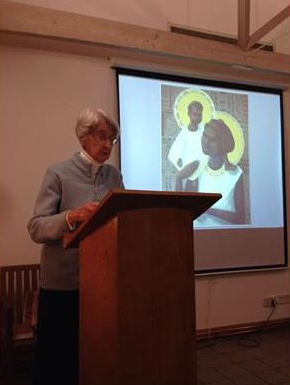September 24, 2018
Mercy Day
By way of introduction to my having been invited to attend the Ecumenical Marian Pilgrimage Trust (EMPT) biennial Conference in 2011 at Walsingham and subsequently to speak at the 2013 and 2015 Conferences, I should mention that my connection came through the Ecumenical Society of the Blessed Virgin Mary (ESBVM) of which I am a life member.
 |
| Marie Farrell rsm speaking at the 2015 EMPT Conference on Australian Aboriginal Spirituality and Our Lady |
This year there were eighty pilgrims welcomed from England, Scotland, Ireland, India, Finland and ‘yours truly’ from Australia. The gathering of laity across denominations, clergy (including several bishops and Church leaders), and religious sisters represented a wonderful microcosm of the communio hoped for among worldwide Christian Churches today – all drawn together at “Mary’s Nazareth” to promote ecumenical reconciliation under the aegis of Our Lady of Walsingham 1.
The pilgrimage programme was carefully designed to allow for participation in ecumenical celebrations of Eucharist 2 in the Anglican, Catholic, Methodist and Orthodox Churches in Walsingham. I was honoured to be reader at the High Mass of the Blessed Virgin Mary in the Anglican Church. Daily scriptural meditations, homilies, talks/presentations 3 and periods of free time were greatly appreciated. Mealtimes were joyfully convivial. Ceremonies traditionally associated with this particular pilgrimage were duly observed: Catholic Benediction, the singing of the Akathist Hymn before the Icon of the Mother of God, individual ‘Sprinkling’ at the Mary Well and the ‘pilgrimage-within-pilgrimage’ from the Anglican Shrine along the ‘holy mile’ to the Catholic ‘Slipper Chapel’ 4 and Church of St Mary for a sung Mass followed by a welcome soup and sandwich lunch on such a cold wintry day. Praying of the Ecumenical Office of the Blessed Virgin Mary marked a ‘Farewell’ to the 2015 pilgrimage.
My own pilgrimage was concluded with a long dreamt of visit to the Catholic Benedictine Monastery at Chevetogne for the Feast of the Annunciation this year. Sisters will recall that it was here that the ARCIC 2 group, which included Australians Fr Peter Cross and Revd Canon Charles Sherlock and Most Revd Peter Carnley, completed the text of Mary: Grace and Hope in Christ. For me it was a graced time for experiencing directly how the monks live, pray and work towards re-connecting the Churches of the East and the West according to the will of Christ that all may be one (Jn 17:11). Words fail to express the sheer sensuous beauty of the architecture, iconography and liturgy of the monastery’s Latin and Byzantine Churches. Nor can they capture the sublime beauty of sound from the monastic choir and the ceremonial pealing of the many bells. 5
Liturgical celebration of the 2015 Feast of the Annunciation will be forever a time to remember. A totally unexpected surprise came when the final Prayer of the Faithful asking for God’s blessing on the Church of Australia was proclaimed in English—such a typical sign of Benedictine hospitality for the only Australian guest present.
Messages to: Marie Farrell rsm
1. See Walsingham website for history of the C10 rise, mediaeval decline and modern re-founding of the now Anglican Shrine of St Mary
2. Eucharistic abstinence was taken into regard where appropriate as the sign that Christian unity has not yet been achieved.
3. See www.ordinariateexpats.com (Issue May 2015) for summary of topics addressed
4. Site where pre-Reformation pilgrims including Henry VIII, removed their shoes in order to walk the Holy Mile barefoot.
5. See www.chevetogne.monastery